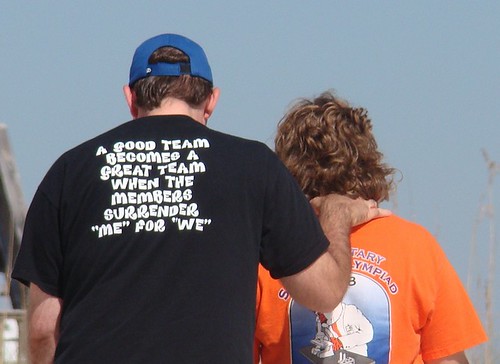Stressed from slept deprivation, barely making it to the airport to make my flight, excited about some important discoveries in the last two days, and very worried about my faux pas from the morning session, I got in the Zone 4 line to board my flight. I could not think of the good discussions from the last two days. I could only worry that some of the progress that was made during the morning session was now been negated by MY bad judgment call.
Taking a moment from my self-absorbed worries, I looked at the line in front of me. Catching my attention was a soldier and his wife are holding hands. They tenderly looked at each other eyes, chatting, and smiling. They advanced the line in sync, making me think that this couple is not only having a sweet moment, but they have an underlying, strong, undefined connection.
Then the soldier turned to the left, smiling and waving to two children who are seated next to the window. The little boy of about four-years old, waved enthusiastically, grinning proudly, and yelled “GOODBYE DADDY!” The mom said “Be sure to wave out the window in a few minutes.” I realized later that this was a strategic directive to help her children look out the window and not at the line where their parents stood. She knew she was going to need a few minutes to catch her composure.
The soldier turned back and embraced his wife. The wife wrapped her arms underneath his, squeezing him. She closed her eyes to hold his embrace in her memory.
He kissed her quickly. Not wanting to leave it at that, he kissed again and again. He released her with one last look into her eyes. He turned to the left to give his boarding pass to the gate attendant. The wife turned slightly to the right, away from him and out of sight of her children, and covered her eyes. She fought back a sob.
My tears flowed, I couldn’t help it, not experiencing her pain, but sympathetic to her loss and her future aloneness. The woman behind me, sniffled and tried hard to keep her emotions quiet. The young lady working the Delta gate discretely wiped her eyes. The men in the line turned their heads; they didn’t want anyone to see their reactions.
As we moved toward the plane, the line straightened, and the soldier stood straightforward, keeping his face from moving the left or right, trying hard to have a moment without letting others see his emotion, loss, pain and heartache. He wiped his face with the back of his hand. He was grateful he had waited until this moment, away from his kids and wife, to release his quiet emotion.
The two children sitting by the window watching the plane have no idea what sacrifices they are making for this war. The wife has now become a temporary single mom. The soldier will feel inadequate at times as a father and husband, not able to be with his family. His return will probably offer unique and uncomfortable challenges.
The little research that has been conducted shows that these continuous deployments are taking its toll on these families. Most of us, including me, simply do not want to be reminded of the soldiers’ and their families’ sacrifices, loneliness, struggles, and pain. We don’t want to think of the emotional, physical, and sometimes, financial challenges of these families. We don’t want to think about how these temporary single parents or grandparents are raising our military children. We don’t want to think about how deployments cause hardships on our own soil. We don’t want to think about the adjustments and challenges of re-integration. We don’t want to think about these stresses because we don’t want for our own emotions to take a hit. Furthermore, some of us think it is not our problem, individually.
President Barack Obama called to action an integrated government approach to military family support, with agencies uniting to create new resources and support programs for military. In addition to governmental and educational support of military families, now more than ever, communities, non-profits and individuals are needed to find ways support these families.
Strong military families keep our US Forces strong.
The encounter at the airport was a striking interruption of my selfish emotion that made me realized that turning a deaf ear to the war’s tolls and to the military families’ hardships is a coward avoidance. One percent of the US population serve in the military, but this 1% needs and deserves the support of the whole 100%.

